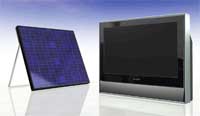Jul 7 2008
During the Hokkaido Toyako Summit (July 7-9, 2008), Sharp Corporation will exhibit its environmentally conscious products and advanced environmental technologies, specifically, LCD TVs in the Environmental Showcase, and solar cells and modules in the Zero Emission House, both located at the International Media Center (IMC). Sharp is cooperating in holding the Hokkaido Toyako Summit (the G8 Summit) by bringing to the world its energy-saving and energy-creating technologies to prevent global warming.
 Sharp 26-inch low-power TV prototype paired with a solar module
Sharp 26-inch low-power TV prototype paired with a solar module
Products to be exhibited as part of the Environmental Showcase and Zero Emission House include:
- 26V-inch Low Power Consumption LCD TV (Prototype) - Uses approximately one-fourth power of a 28-inch CRT TV having nearly the same screen area.
- AQUOS LCD TVs - AQUOS LCD TVs will be featured in 12 locations inside the Environmental Showcase, in particular, a 57V-inch AQUOS will display welcome messages and other information in the entrance hall.
- Thin-Film Solar Cell Module - A triple-junction thin-film solar cell module and a see-through solar module for which Sharp has successfully developed mass-production technologies will be on display as examples of Japanese solar energy technologies that have made a quantum leap in innovation.
- Solar-LED Lighting Module - Exhibited as an example of environmentally friendly infrastructure products that fulfill its function even in times of disaster.
- 65V-inch Next-Generation LCD TV (Prototype) - This prototype next-generation LCD TV featuring breathtaking image quality, a super-thin profile, and advanced environmental performance will be mounted on the living room wall as the main TV of the Zero Emission House.
The 26V-inch Low Power Consumption LCD TV uses approximately one-fourth the power and has about one-third the annual energy consumption of a conventional 28-inch CRT TV having nearly the same screen area. Even compared to existing LCD TVs, the low power consuming design uses about one-third the power and has around one-half the annual energy consumption. It can also be used even in off-grid areas when paired with a solar power system. The extremely low power consumption of this LCD TV means it can also be run, for example, from a solar module whose surface area roughly equals the viewing area of the screen. Marketing a combination of this LCD TV paired with a solar energy system will not only contribute to the environment, but also make it possible to watch TV even in areas where utility-supplied electricity is unavailable. An estimated 1.6 billion people are said to live in such areas worldwide, and this pairing could be expected to aid in improving the lives of these people.
The triple-junction thin-film solar cell module is perfect for powering this television. The Thin-film solar cells use significantly less refined silicon than crystalline solar cells, plus the energy used when fabricating the solar cells is lower because of fewer processing steps. And the fact they use no rare or scarce metals, or materials regulated under the RoHS Directive, means they are highly cost-effective and offer a high level of environmental performance.
For further information, please visit http://sharp-world.com/eco-showcase/